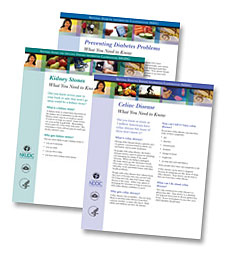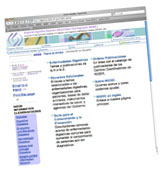Winter 2008 (PDF)
Contents
 Celiac Disease and Dental Problems
Celiac Disease and Dental Problems
Dental enamel defects are one of the many diverse manifestations of celiac disease. Dentists and other health care providers can help identify patients with celiac disease by looking for this dental problem. The Celiac Disease Awareness Campaign has a new feature article about celiac disease and dental problems at www.celiac.nih.gov.
[Top]
Continuing Medical Education
 If your organization is planning a continuing medical education (CME) program about celiac disease, consider using materials from the Awareness Campaign. The Georgia Academy of Family Physicians (GAFP) recently used the Awareness Campaign’s fact sheet about celiac disease and the National Institutes of Health Consensus Statement on Celiac Disease booklet for a CME lecture entitled “Celiac Disease: A Hidden Epidemic.” Program planners reported the resources were well-received. GAFP members ranked celiac disease a priority lecture topic for 2007. All educational materials are available on the Awareness Campaign website at www.celiac.nih.gov/Materials.aspx. Multiple copies can be ordered online.
If your organization is planning a continuing medical education (CME) program about celiac disease, consider using materials from the Awareness Campaign. The Georgia Academy of Family Physicians (GAFP) recently used the Awareness Campaign’s fact sheet about celiac disease and the National Institutes of Health Consensus Statement on Celiac Disease booklet for a CME lecture entitled “Celiac Disease: A Hidden Epidemic.” Program planners reported the resources were well-received. GAFP members ranked celiac disease a priority lecture topic for 2007. All educational materials are available on the Awareness Campaign website at www.celiac.nih.gov/Materials.aspx. Multiple copies can be ordered online.
[Top]
NIDDK Awareness and Prevention Series Available
 The National Institute of Diabetes and Digestive and Kidney Diseases (NIDDK) has created a new health information series to raise awareness about digestive diseases, diabetes, and kidney and urologic diseases among people not yet diagnosed with these illnesses.
The National Institute of Diabetes and Digestive and Kidney Diseases (NIDDK) has created a new health information series to raise awareness about digestive diseases, diabetes, and kidney and urologic diseases among people not yet diagnosed with these illnesses.
The Awareness and Prevention Series, which the NIDDK developed for community health fairs, workplace health forums, family reunions, and similar events, features two page fact sheets—one side in English and the other in Spanish—on a wide range of health topics, including celiac disease. Each fact sheet gives readers a snapshot of an illness, highlighting risk factors, symptoms, prevention tips, and where to go for more information. In addition to celiac disease, digestive diseases fact sheets address lactose intolerance, irritable bowel syndrome, colon polyps, bacteria and foodborne illness, and hepatitis.
“The series is designed to encourage readers to ask ‘Could this be me or someone I care for?’” said Kathy Kranzfelder, director of the NIDDK Information Clearinghouses. “Raising awareness of these illnesses, we hope, will help people learn to prevent them or see a doctor if they have symptoms.”
Copies of the celiac disease fact sheet and other publications are available on the Awareness
Campaign website at www.celiac.nih.gov/Materials.aspx. For additional Awareness and Prevention Series publications about digestive diseases, go to www.digestive.niddk.nih.gov/ddiseases/ap.htm.
[Top]
NIDDK Website Features Health Information in Spanish
 The National Institute of Diabetes and Digestive and Kidney Diseases (NIDDK) has launched a new portal featuring Spanish-language digestive diseases materials and resources on its website.
The National Institute of Diabetes and Digestive and Kidney Diseases (NIDDK) has launched a new portal featuring Spanish-language digestive diseases materials and resources on its website.
People looking for information about digestive diseases in Spanish can now go directly to the
Spanish-language portal page, where they will find an A to Z list of topics and titles. The online system for ordering NIDDK materials now includes descriptions in Spanish of available publications to help visitors choose the resources they want. The National Digestive Diseases Information Clearinghouse has 19 publications about digestive diseases in Spanish and will be adding more in the future.
The new Spanish-language portal is available at www.digestive-espanol.niddk.nih.gov. Spanish portals for diabetes and kidney and urologic diseases information also are now available at
www.diabetes-espanol.niddk.nih.gov and www.kidney-espanol.niddk.nih.gov.
[Top]
RESOURCES
 Celiac Disease Resource Available in Spanish
Celiac Disease Resource Available in Spanish
Copies of the easy-to-read booklet about celiac disease written in Spanish can now be ordered from the Awareness Campaign. The 20-page booklet explains what celiac disease is and describes the symptoms, diagnosis, and treatment. What I need to know about Celiac Disease also includes an updated chart from the American Dietetic Association that lists which foods to avoid and which ones are safe to eat on a gluten-free diet. Single copies of the booklet are free. A $10 shipping and handling fee is charged for each package of 25 copies. To order the booklet, go to www.celiac.nih.gov/Materials.aspx.
[Top]
Featured in the NIDDK Reference Collection
Dermatitis Herpetiformis
Dermatitis herpetiformis (DH) is an important associated disorder or complication of celiac disease. DH is characterized as an intensely itchy skin eruption distinguished by the formation of small papules or vesicles. Although its severity may vary, DH is a lifelong condition.
An online publication by the Celiac Sprue Association, a national support organization that offers information and referral services, describes DH, including the genetics, immune system changes, treatment strategies, and associated disorders. The publication emphasizes that a gluten-free diet has distinct advantages for a person with DH––it reduces necessary medications and their associated complications, improves gastrointestinal symptoms, and is aimed at the cause rather than the symptoms of the disease.
To access the publication, go to www.csaceliacs.org and click on “Dermatitis Herpetiformis.” For more information about DH or celiac disease, contact the Celiac Sprue Association/United States of America, Inc., P.O. Box 31700, Omaha, NE 68131–0700, 402–558–0600, celiacs@csaceliacs.org.
The National Institute of Diabetes and Digestive and Kidney Diseases (NIDDK) Reference Collection is a free, online database that helps health care professionals, health educators, patients, and the general public find educational materials not typically referenced in most databases. The NIDDK does not control or endorse the information contained in this collection; the information is provided as a convenience to our visitors.
Visit the Reference Collection at www.catalog.niddk.nih.gov/resources to find more celiac disease resources.
[Top]
Upcoming Meetings, Workshops, and Conferences
The Celiac Disease Foundation (CDF) will hold its annual conference in Los Angeles on
May 3, 2008. For more information, contact the CDF at 13251 Ventura Boulevard, #1, Studio City, CA 91604, 818–990–2354, cdf@celiac.org, www.celiac.org.
The Celiac Disease Awareness Campaign will have materials available at the following upcoming conferences:
The 66th Annual Meeting of the American Academy of Dermatology. The meeting will be held from February 1 to 5, 2008, in San Antonio. For more information, go to www.aad.org/professionals/MeetingsEvents/66AM.htm.
The American College of Physicians Annual Meeting. The meeting will be held from May 15 to 17, 2008, in Washington, DC. For more information, go to www.acponline.org/cme/as/im08.htm?hp.
The Society of Gastroenterology Nurses and Associates Annual Course. The meeting will be held from May 16 to 21, 2008, in Salt Lake City. For more information, go to www.sgna.org/Education/events/AnnualCourse/2008/2008AdvPro_FINAL.pdf.
Digestive Disease Week. The meeting will be held from May 17 to 22, 2008, in San Diego. For more information, go to www.ddw.org.
The American Academy of Physician Assistants Annual Conference. The meeting will be held from May 24 to 29, 2008, in San Antonio. For more information, go to www.aapa.org/annual-conf.
Celiac Disease News, an email newsletter, is sent to subscribers four times a year by the National Digestive Diseases Information Clearinghouse (NDDIC). The newsletter features news about celiac disease, special events, patient and professional meetings, and new publications available from the NDDIC and other organizations.
If you would like to subscribe, go to http://catalog.niddk.nih.gov/newsletter.cfm. You can read or download a PDF version of the newsletter at http://www.celiac.nih.gov/CeliacNewsltr_winter08.pdf.
To meet the need for comprehensive and current information about celiac disease, the NDDIC, a service of the National Institute of Diabetes and Digestive and Kidney Diseases (NIDDK), launched the Celiac Disease Awareness Campaign. The Awareness Campaign is the result of the combined ideas and efforts of the professional and voluntary organizations that focus on celiac disease, along with the NIDDK, the National Institutes of Health, and the Centers for Disease Control and Prevention.
Visit www.celiac.nih.gov to learn more about the Awareness Campaign.
 Executive Editor: Stephen P. James, M.D.
Stephen P. James, M.D., is the director of the Division of Digestive Diseases and Nutrition within the NIDDK. As director, Dr. James oversees planning, implementation, and evaluation of a national research effort focused on gastrointestinal, pancreatic, hepatobiliary, and nutrition diseases and conditions. Before joining the NIDDK in 2001, Dr. James directed the division of gastroenterology at the University of Maryland’s School of Medicine for 10 years.
Executive Editor: Stephen P. James, M.D.
Stephen P. James, M.D., is the director of the Division of Digestive Diseases and Nutrition within the NIDDK. As director, Dr. James oversees planning, implementation, and evaluation of a national research effort focused on gastrointestinal, pancreatic, hepatobiliary, and nutrition diseases and conditions. Before joining the NIDDK in 2001, Dr. James directed the division of gastroenterology at the University of Maryland’s School of Medicine for 10 years.



National Digestive Diseases Information Clearinghouse
2 Information Way
Bethesda, MD 20892–3750
Phone: 1–800–891–5389
Fax: 703–738–4929
Email: nddic@info.niddk.nih.gov
Privacy | Disclaimer | Accessibility